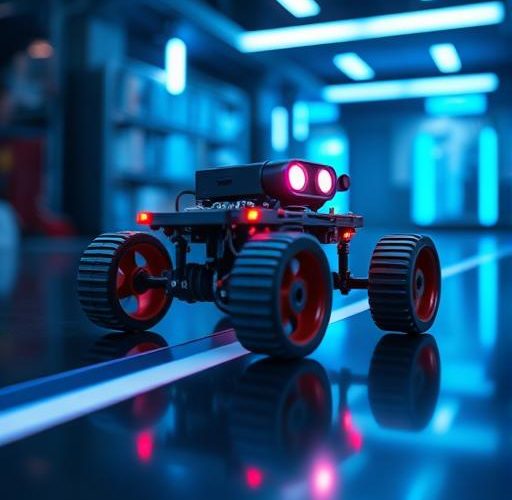Table of Contents Show
Arduino line follower robots are a fascinating blend of electronics, programming, and robotics, making them an excellent project for beginners and enthusiasts alike. These robots are designed to follow a predefined path, typically a black line on a white surface, using sensors and a microcontroller. They are widely used in educational settings, robotics competitions, and even industrial automation. In this guide, you’ll learn everything you need to know about building your own Arduino line follower robot, from understanding its components to programming and optimizing its performance. Let’s dive in!
Understanding Line Follower Robots
What is a Line Follower Robot?
A line follower robot is an autonomous vehicle that detects and follows a line drawn on the ground. It uses sensors to detect the line and a microcontroller to process the sensor data and control the motors. The key components include sensors (like IR or QC sensors), a microcontroller (such as Arduino), motors, and a chassis. There are two main types of line follower robots: edge detection robots, which follow the edge of a line, and center line following robots, which stay centered on the line.
How Does an Arduino Line Follower Robot Work?
An Arduino line follower robot works by using sensors to detect the line and sending this data to the Arduino microcontroller. The Arduino processes the data and makes decisions to control the motors, ensuring the robot stays on the line. Sensors like IR or QC modules detect the line, while a motor driver (such as the L298N) controls the motors using PWM signals. The robot’s decision-making can be based on simple threshold-based logic or more advanced algorithms like PID control for smoother movement.
Components Required for Building an Arduino Line Follower Robot
Essential Hardware Components
- Arduino board (Uno, Nano, or Mega)
Software Requirements
To program your Arduino line follower robot, you’ll need the Arduino IDE installed on your computer. Depending on your project, you may also require specific libraries for sensors or motor drivers. A basic understanding of C++ programming is helpful, as you’ll be writing code to control the robot’s behavior.
Step-by-Step Construction Guide
Assembling the Robot Chassis
Start by selecting a chassis that suits your project. Mount the motors and wheels securely, ensuring they are aligned properly. Place the sensors at the front of the chassis, spaced evenly to detect the line accurately. A well-designed chassis is crucial for stability and performance.
Wiring Connections
Connect the motors to the motor driver and link the motor driver to the Arduino. Attach the sensors to the Arduino’s input pins, ensuring proper wiring. Power the system using a battery or USB connection, depending on your setup. Double-check all connections to avoid issues during testing.

Uploading & Debugging the Code
Write a basic line-following algorithm in the Arduino IDE and upload it to the board. Calibrate the sensor thresholds to ensure accurate detection. Test the robot on a line and troubleshoot any issues, such as incorrect motor behavior or sensor misalignment. Debugging is a critical step to ensure smooth operation.
Programming the Arduino Line Follower Robot
Basic Line-Following Algorithm
The basic algorithm involves reading sensor values and using conditional statements (if-else or switch-case) to control the motors. For example, if the left sensor detects the line, the robot turns left. PWM signals are used to control motor speed, ensuring smooth movement.
Advanced Techniques (Optional)
For more advanced performance, consider implementing PID control to adjust motor speeds dynamically. You can also optimize the robot’s speed by fine-tuning the code and using multi-sensor fusion to improve accuracy. These techniques require a deeper understanding of programming and robotics but can significantly enhance the robot’s capabilities.
Testing & Improving Performance
Initial Testing & Calibration
Begin by testing the robot on a simple black line on a white surface. Adjust the sensor sensitivity and motor speeds to ensure the robot follows the line accurately. Calibration is essential to account for variations in surface reflectivity and lighting conditions.

Enhancing Accuracy & Speed
To improve accuracy, consider using higher-quality sensors like QRE1113 or TCS3200. Optimize the code for faster sensor readings and reduce noise interference by shielding the sensors. Experiment with different motor speeds to find the optimal balance between speed and control.
Applications & Future Enhancements
Real-World Uses of Line Follower Robots
Line follower robots are widely used in educational projects to teach robotics and programming. They are also popular in robotics competitions and have practical applications in industrial automation, such as warehouse navigation and material handling.
Upgrading Your Line Follower Robot
Once your basic robot is functional, you can explore upgrades like adding Bluetooth or Wi-Fi control for remote operation. Integrate obstacle avoidance features using ultrasonic sensors or implement machine learning algorithms for adaptive learning. The possibilities are endless!
Conclusion
Building an Arduino line follower robot is a rewarding project that combines electronics, programming, and problem-solving skills. By following this guide, you’ve learned the essential steps to create your own robot, from assembling the components to programming and optimizing its performance. Now it’s your turn to get started! Share your creations, experiment with new ideas, and take your robotics skills to the next level.
FAQs (Frequently Asked Questions)
Q1: What sensors are best for an Arduino line follower robot?
IR sensors (like TCRT5000) or specialized line sensors (QRE1113) work well for most projects.
Q2: How can I improve the robot’s speed without losing accuracy?
Fine-tune PID values, use high-torque motors, and optimize code for faster sensor readings.

Q3: Can I use any Arduino board for a line follower robot?
Yes, but Arduino Uno or Nano are commonly used due to their simplicity and affordability.
Q4: What if my robot keeps deviating from the line?
Check sensor alignment, recalibrate thresholds, and ensure the surface is clean and well-contrasted.
Q5: How do I make my line follower robot follow curved paths?
Implement smoother motor speed adjustments and use multiple sensors for better curve detection.




